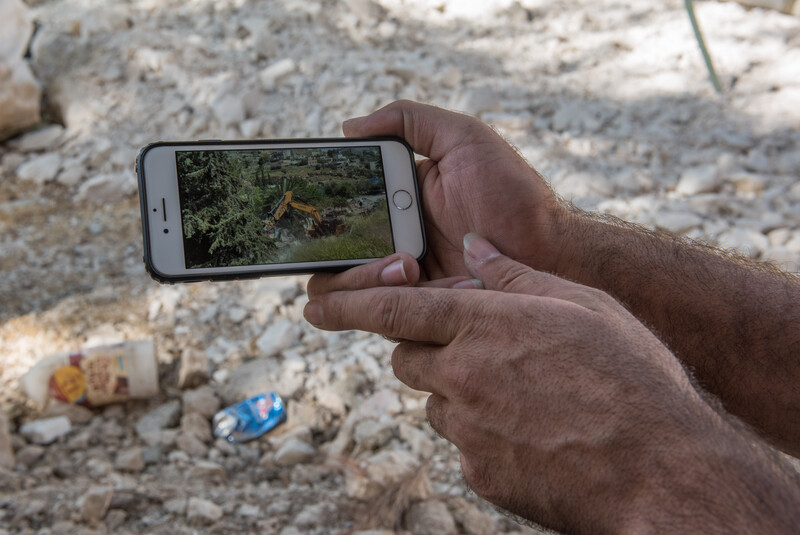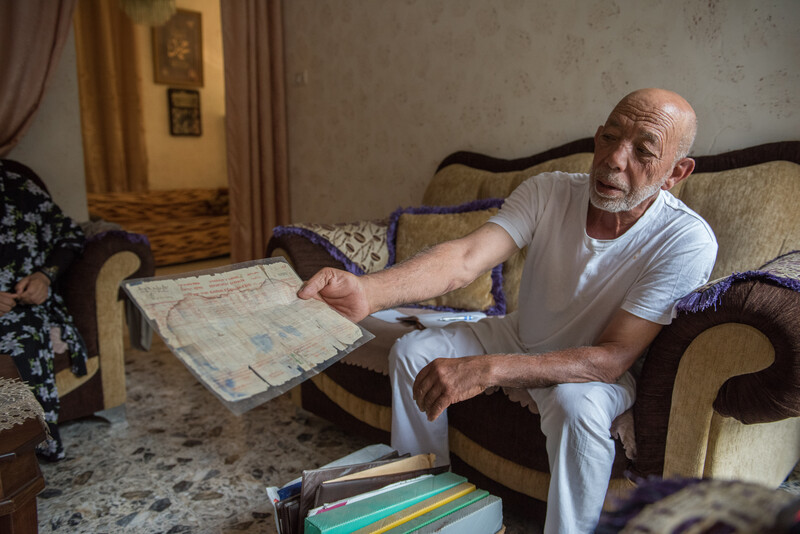 By Annelies Keuleers: The setting sun painted the houses on the hills of East Jerusalem yellow. A few ducks and chickens scrambled around amid a seemingly random collection of items.
By Annelies Keuleers: The setting sun painted the houses on the hills of East Jerusalem yellow. A few ducks and chickens scrambled around amid a seemingly random collection of items.Qusay Burqan stands in front of the rubble of a barrack where he used to store food for his sheep. Israeli municipal authorities demolished his house and two structures for his sheep and chicken, along with his brother’s house on 30 April.
The items had been rescued from Qusay Burqan’s house, demolished at the end of April when Israeli municipal authorities sent in bulldozers to Wadi Yasul, between the Silwan and Abu Tur neighborhoods of occupied East Jerusalem, to clear away the homes of Qusay and his brother Anas.
Eleven people were left homeless, including seven children, and Qusay said he felt almost numb when it happened.
“It is hard to explain how I felt. I knew my hands were tied,” Qusay remembered, having placed two chairs in front of the rubble to sit and talk with this reporter. “I saw all of this happening before my eyes and I could not do anything because any move I would make, they would beat and arrest me.”
The Israeli forces who turned up that early April 30 morning consisted of border police and special forces along with municipal personnel.
But when neighbors came to help Qusay and his family – warned by a WhatsApp group the community runs specifically for such a reason – the Israelis responded with beatings and bullets.
Five residents were seriously wounded, according to the United Nations, when Israeil forces used physical force, stun grenades and sponge-covered bullets to disperse the crowds.
Anas, whose house was also demolished, was shot in the back with a sponge bullet and arrested before being released on bail on 2 May.
“They beat his face so badly it was hard to recognize him,” Qusay said. “And we had to pay 20,000 shekel bail” - more than $5,500.
Qusay does not know what he will do next. For now, he is renting a room where he lives with his wife and three children in the adjacent area of al-Thuri. He says he wants to rebuild his house because he has no other option.
Community under threat
Wadi Yasul is a tiny part of Silwan. One cracking asphalt road sports a number of modest houses and small orchards of olive trees. The community enjoys a village feel and residents keep close and warm relations. Guests are made to feel welcome.But such tranquility belies reality. Wadi Yasul’s residents live in constant fear. There is a demolition order against every house – some 60 homes and other structures, according to the UN – in an area Israeli authorities have “zoned” as forest land but is home to some 700 people.
For 15 years residents have been trying to change the zoning designation of the area to residential. For 15 years they have failed.
Ramadan Shalodi, 76, says that not granting building permits to Palestinians is “the municipality’s policy.” He recalls receiving the first demolition order against his house in the early 1990s. He appealed in court, but lost. Since then he has paid more than $8,500 in fines in addition to nearly $300 to apply for a retroactive permit that was denied.
His house remains under threat of demolition. “Maybe I should rent another place,” he said. “So I have somewhere to go when they destroy my house. But I am not a millionaire.”
Another resident, a father of four who preferred not to give his name for fear of possible repercussions, demolished the second floor of his own home last year. He said the Israelis didn’t give him a choice.
“They told me either you demolish it or we do it for you. And if we demolish it, you will pay.”
The fee the authorities would have demanded to demolish his home for him? Around $25,000.
The man now lives with his wife and three of his children in a two-room single floor house.
“We are not asking to build villas here, just for the most basic human rights to live in safety in our homes,” another resident, who also asked to stay anonymous, said.
Racist zoning
The pace of home demolitions in occupied East Jerusalem has dramatically accelerated this year, with more Palestinians displaced in the first four months of 2019 than in all of 2018.But a lack of permits is only one reason Israeli authorities cite in demolishing Palestinian homes. Just last month, Israel began the destruction of some 100 apartments in 13 buildings in Sur Bahir, not far from Wadi Yasul on the outskirts of Jerusalem.
The buildings are in Area A of occupied territory and therefore, in theory, under full Palestinian Authority civil and security control. But Israel decided they had been built too close to Israel’s separation wall – which is built deep inside occupied territory at this juncture – and blew them up.
Just some 12 percent of East Jerusalem is currently zoned for Palestinian construction. With a population that has increased fivefold since 1967, this leaves precious little space on which to expand. Add to it an application system that almost by definition precludes approval, and Palestinians in Jerusalem have been forced to build without permits in order to respond to population pressure.

Wadi Yasul is located in the so-called “Peace Forest,” a collection of trees planted by the Jewish National Fund following the occupation of East Jerusalem and after the area, already densely populated, was designated a national park in 1970.
“They designated so much area as green space here, you’d think we’re in the Swiss Alps, not in Jerusalem,” Ziad Kawar, lawyer for the community in Wadi Yasul, said. He explained that it’s nearly impossible to have houses in Wadi Yasul retroactively legalized, because the municipal zoning plan designates Wadi Yasul green space and courts tend to follow municipal legislation.
This is not due to a lack of effort from residents. Since 2004, residents said, they have shared the costs of hiring three different urban planners who have drawn up four different plans to try to convince the municipality to change the zoning designations. All were rejected, even though the municipality originally encouraged residents to submit plans, giving the impression that the neighborhood would eventually be legalized.
In April, Israel’s supreme court rejected an appeal filed by the community, leaving the entire community at risk of displacement.
The residents told The Electronic Intifada they had paid thousands of dollars for lawyers and urban planners, while also paying thousands of shekels for municipal taxes and in fines for building illegally.
“We have submitted so many plans to the municipality, they always refused,” one resident, who wanted to remain anonymous, said. “And if Jews want to come live here, they will make everything easy for them.”
Settlers target Silwan
While the residents of Wadi Yasul struggle to have their homes recognized, the Jerusalem municipality has been supportive of Israeli settlers retroactively legalizing structures they erected illegally in the same area.The Jerusalem Municipality in March submitted a request to the District Planning and Building Committee to have the zoning of the “Peace Forest” changed to “open public space.” This allowed Israeli settler organization Elad to have tourist and visitor facilities the group built illegally retroactively legalized. This decision also expedited the organization’s project to build a cable car for tourists from Talpiot, south of Jerusalem.
Silwan is a primary target for Elad, an organization whose declared objective is to “Judaize” East Jerusalem by moving in as many Israeli settlers as possible.
On 10 July, settlers belonging to Elad took over part of the Siyam family house in the Wadi Hilweh area of Silwan. Jawad Siyam, director of the Wadi Hilweh information center and a community leader, saw his relatives being evicted from their house by dozens of Israeli border police and the family is now forced to share their home with settlers.
“It is very difficult,” Siyam said. “Because they know the police are on their side, they are constantly trying to provoke us.”
The legal battle with Elad goes back 25 years, Siyam told The Electronic Intifada, during which time the settler organization has brought six different legal cases against the family.
Elad works closely with the Israeli government and plays a major role in the Israeli tourism industry in East Jerusalem. It sponsors archaeological excavations in the center of Wadi Hilweh, where the Israelis are unearthing the so-called City of David.
This is both a tourist attraction – with the “City of David National Park” and tours that convey an exclusive Jewish-centric version of history to tourists – and an attempt to lay claim to the area by proving a Jewish presence there thousands of years ago.
The excavations have left a large crater in the heart of Wadi Hilweh, and include tunnels dug under Palestinian homes, threatening these with collapse. One such tunnel was recently inaugurated by US Middle East envoy Jason Greenblatt and the US ambassador to Israel David Friedman.
In the face of this well-supported and well-financed settler onslaught, Siyam remains defiant, if worried.
“Even though they are trying very hard, their settlement project isn’t succeeding,” Siyam argued, saying the plan was to move 15,000 settlers into settlements in Palestinian villages in and near the Old City, but that the actual number is less than half that figure.
The UN puts the number of Jewish settlers in the so-called Holy Basin even lower, at 3,500.
“But there is an appearance of them being a majority,” he said. “Because they have the Israeli flags on their buildings, while we are not allowed to put up Palestinian flags or symbols. They have the money, the police. They control the tourist sites. They have the power.”
The magic of Jerusalem
It has been long-standing Israeli policy to re-establish a 70 percent Jewish majority in Jerusalem not seen since 1967. That year, when Israel occupied the eastern part of Jerusalem, approximately 26 percent of the Jerusalem population was non-Jewish Palestinian and 74 percent Jewish.Today, the balance is closer to 60-40. Israel’s “demographic threat” anxiety has thus seen the Israeli National Security Council consider a plan to redraw the borders of the Jerusalem municipality – which have already been redrawn twice before, in 1985 and 1993 – to exclude Palestinian neighborhoods.

But in Wadi Yasul, they emphasized that leaving was not an option. Moving to the West Bank would mean being cut off from their entire lives in Jerusalem, since West Bank residents are not allowed to go to Jerusalem without permits.
“We are like a fish in the water: if you take us out of our homes, we die,” one anonymous resident claimed.
“If they ever ask me to choose between Israel or the PA, or anything else, my answer will always be Jerusalem,” said Khaled Shweikeh, a 39-year-old resident of Wadi Yasul. “Jerusalem has its own special taste to it. It is like magic.”
“We will not leave,” Shweikeh said. “And when they demolish our homes, we find joy in rebuilding them.”
“We have been here since forever. We will not leave.”
Annelies Keuleers is a Belgian journalist based in Ramallah.
Source
R.I.P.
1979~2003

No comments:
Post a Comment